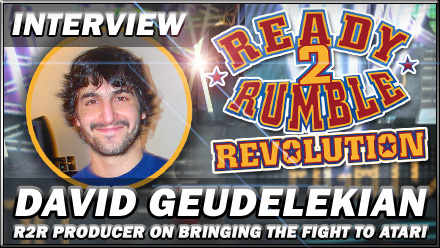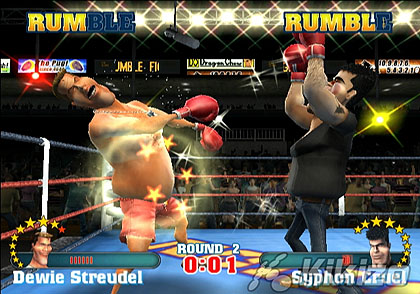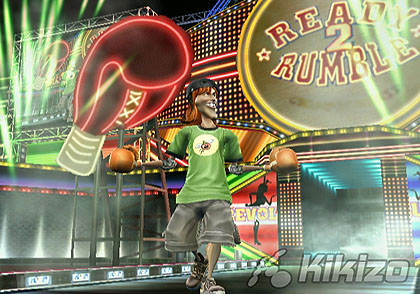Ready 2 Rumble Revolution - Atari Interview
The producer of Ready to Rumble Revolution on bringing the fight to Atari.

Released in North America alongside the Dreamcast in late 1999, Midway's Ready 2 Rumble was a colourful, comic jaw-bludgeoner which won its host hardware a lot of early praise. Since then Sega has discontinued its console career and Midway has nosedived into debt, but the game's star still shines amidst these dismal events, and Atari, the industry's reigning comeback kid, has decided it deserves another shot. Developed by Japan-based AKI Corporation with assistance from the now-defunct 10tacle Studios, Ready 2 Rumble Revolution brings the original's chunky toon vibe and arcade fighting style to the Nintendo Wii.
The new controls don't take much unravelling: your nunchuk is one glove, the Wiimote is the other. Thrusting or flicking either of these throws a punch, and holding C while doing so lets you throw body shots. Wiggling both nunchuk and remote in concert makes your character dodge and weave, Z blocks, and A activates a special "Rumble" attack. As with many motion-sensing control schemes your mileage may vary, but it's safe to say the game won't go down in the first round.
It should be standing at the end of the fight, too, with 18 caricatured celebrity boxers, mini-game training packages, well-muscled character creation suite and career mode. Kikizo stepped into the ring with David Geudelekian, Producer at Atari, to discuss the strength of the IP, Revolution's relaxed combo timing and celebrities who really need to get over themselves.
Kikizo: So, Ready 2 Rumble. It's been a while.
Geudelekian: It has been a while, hasn't it! But it was well-loved, you know - great as a fighting game, great as a mix of cartoon with competitive multiplayer.
Kikizo: It was certainly one of the most memorable early Dreamcast titles. So what have you got in store for the 2009 outing?
Geudelekian: Basically what we're doing here is mixing the casual and hardcore audiences. We had to recreate everything the fans love about it - it's a competent fighter that is legible, fun, ready to rock - but then in this case we still want to make it accessible, easy to get into. So we created quite a cool little control scheme. And this is really AKI stepping in...
Kikizo: What have AKI worked on previously?
Geudelekian: AKI have done wrestling [games], they've done a bunch of Japan-only arcade titles - they're award-winning in Japan, they're well-known out of Japan... AKI Pro Wrestling is their biggest series, and that has made it far and wide. They're a very technical wrestling squad, so you're talking about, you know, 12 hit zones per character, box grapples, stuff like that.
But for this, we approached it pretty simply. There are four hit zones - top-left, top-right, bottom-left, bottom-right - and three types of attack. You've got your jab, your hook and your upper cut. We've got this queue system, kind of like Pro Evo 9, where if you've started to complete a motion before the animation set is played out, it's still going to remember those basic commands.
Kikizo: So you can throw rapid combinations of attacks...
Geudelekian: Exactly, you can buzz in a whole flurry of punches.
Kikizo: Is there a cut-off point for queuing attacks?
Geudelekian: Not when I go to Japan and get my ass kicked by the developers! It seems as though they're infinite, I don't know how they do it. [laughs] I've pulled off a seven-hit combo... It's quite deep, it goes deep.
Kikizo: Depth is something I was curious about. I spoke to the Facebreaker designer recently, and while that game looked like it had potential, there's apparently no depth to it at all. It's rock-paper-scissors.
Geudelekian: It really is rock-paper-scissors. Unfortunately they used their gestures in a timing-based way, and it made it really impossible to pull it off... So in this way we really want to make it as legible, as competent, as a fighting game should be. The casual player will find it really easy to jump into it... but then for fans of the series it's really a return to form, it's very much a console fighter - a joypad fighter that's been mapped properly to this kind of controller.
Kikizo: Because there are plenty of games that don't map the controls properly to the controller.
Geudelekian: And there are a lot of hardware limitations on the Wii, like for example the Z-planing is very difficult - it's the worst and least sensitive motion for the Wii. So instead of using the motion sensor for that movement, we actually use the accelerometer, just to activate it. And that's great, because we don't have accelerometer-based punches where you have to swing extra hard to get an extra hard hit. Ready 2 Rumble at its roots, it's not that kind of fighter - there's one hit strength and it's hard. So we can concentrate on things like making sure the player has full control.







 Satoru Iwata Video Interview - the late Nintendo president spoke with Kikizo in 2004 as 'Nintendo Revolution' loomed.
Satoru Iwata Video Interview - the late Nintendo president spoke with Kikizo in 2004 as 'Nintendo Revolution' loomed. Kaz Hirai Video Interview - the first of Kikizo's interviews with the man who went on to become global head of Sony.
Kaz Hirai Video Interview - the first of Kikizo's interviews with the man who went on to become global head of Sony. Ed Fries Video Interview - one of Xbox's founders discusses an epic journey from Excel to Xbox.
Ed Fries Video Interview - one of Xbox's founders discusses an epic journey from Excel to Xbox. Yu Suzuki, the Kikizo Interview - we spend time with one of gaming's most revered creators.
Yu Suzuki, the Kikizo Interview - we spend time with one of gaming's most revered creators. Tetris - The Making of an Icon: Alexey Pajitnov and Henk Rogers reveal the fascinating story behind Tetris
Tetris - The Making of an Icon: Alexey Pajitnov and Henk Rogers reveal the fascinating story behind Tetris Rare founders, Chris and Tim Stamper - their only interview? Genuinely 'rare' sit down with founders of the legendary studio.
Rare founders, Chris and Tim Stamper - their only interview? Genuinely 'rare' sit down with founders of the legendary studio. The History of First-Person Shooters - a retrospective, from Maze War to Modern Warfare
The History of First-Person Shooters - a retrospective, from Maze War to Modern Warfare